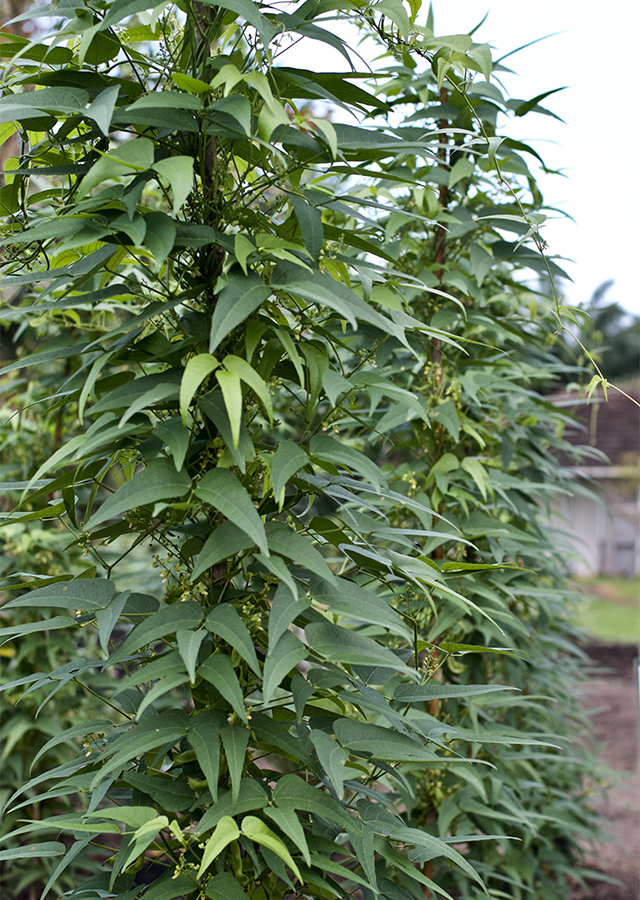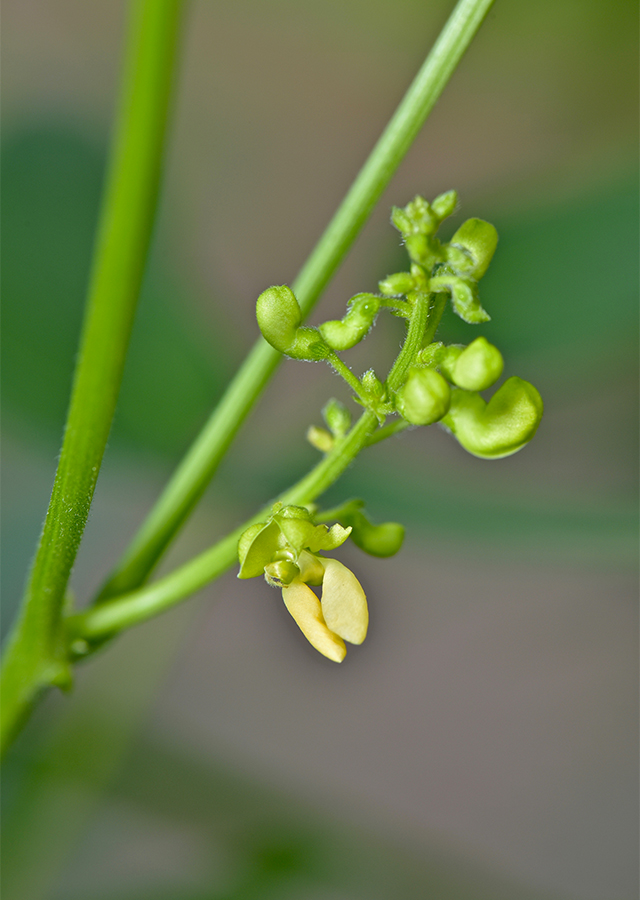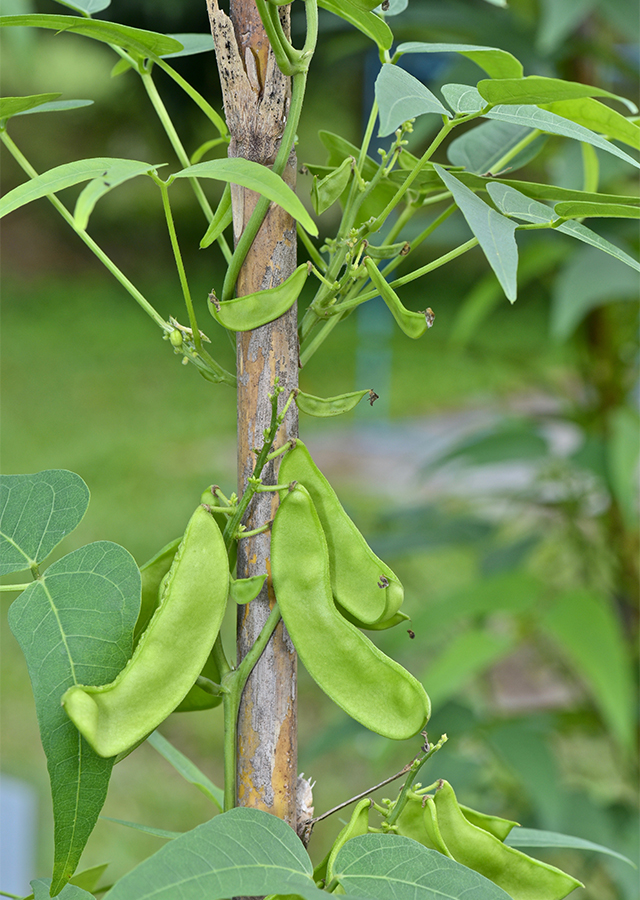Lima Bean
Phaseolus lunatus L.
Fabaceae
Location in our garden
Vegetable



Synonym
Dolichos tonkinensis Bui-quang-Cheu
Phaseolus amazonicus Benth.
Phaseolus bipunctatus Jacq.
Habitus
Climbers. Phaseolus lunatus is an annual herbaceous perennial climbing plant producing twining stems generally up to 4 meters long, though sometimes as much as 8 meters long, from a fibrous rootstock that can be somewhat fleshy.
Part Used
Leaves
Seeds
Bark
Growing Requirements
Full Sunshine
Drought Resistant
High Rainfall
Habitat
Riverbanks
Grassland
Overview
From Northern Mexico to Southern Argentina and Paraguay, lima bean is native to tropical and subtropical America. It has been grown all over the world and is now available for cultivation and naturalization in the West Indies, Asia, Africa, Europe, and the Pacific Islands. A very common food crop, Lima bean is used primarily for its seeds and immature seedpods.
Vernacular Names
Haricot de lima (French), Frijol lima (Spanish,Mexican), Mian dou (Chinese), Bakla (India), Patani (Philippine), Kacang cina (Malaysia), Burma bean (Burma), kratok (Indonesia), thua rachamat (Thailand), dâu ngu (Vietnam).
Agroecology
Grows best in lowland tropical areas at elevations up to 1,500 m. During the growing season, lima beans are typically tolerant of heavy rainfall. Annual precipitation of 900-1,500 mm is sufficient, but once formed, it tolerates as little as 500-600 mm of precipitation. In fields where temperatures range from 16 to 27 °C, it grows stronger. A well-drained, moderately fertile soil in a sunny position includes Lima beans. Sandy loam and a pH of 6-7 are favored.
Morphology
- Roots - has a highly branched root system, reaching depths of more than 1 m.
- Stems - obtuse-pentagonal or cylindrical, puberulent.
- Leaves - alternating, chartaceous leaflets, acute or short-acuminate apex, sinuous margins, glabrous, dark green upper surface, dull, light green or glaucous lower surface, 5.5-11 x 3.5-7.5 cm terminal leaflets, 1.5-2.5 cm long rachis, 6.6-9 cm long petioles, sulcate, puberulent, the base slightly broadened.
- Flowers - greenish or pale yellow, about 10 to 13 mm long, on axillary and solitary racemes 8 to 20 cm long. Calyx 2-2.5 mm long, green, campanulate, the sepals deltate, corolla white or lilac, pink or bluish, the standard semicircular, stamens 10.
- Fruits - an oblong-falcate legume or in the form of halfmoon, flattened, 5-7 x 1-2 cm, puberulent with uncinate hairs or glabrescent, dehiscent by valves that open in a spiral containing 2-4 seeds.
- Seeds - reniform, flattened, approximately 7 mm long, reddish brown with dark spots.
Cultivation
Propagation is by seeds. Pre-soak the seed in warm water for 12 hours and sow it about 1-3 cm deep in situ. Within 10 days, germination should take place. At temperatures under 16 °C, seeds will not germinate.
Chemical Constituents
Flavonoids, alkaloids, phytin, lectin, saponins, tannins, phenolic (gallic acid, caffeic acid, ellagic acid, rutin, quercetin, kaempferol).
Traditional Medicinal Uses
Medicinal Uses
- Hypolipidemic, hypoglycemic, antibacterial, antifungal, antiproliferative, estrogenic, hepatoprotective, nephroprotective, anti-hypertensive and antioxidant properties have been suggested in research.
Traditional Uses
- Children are given leaf juice, combined with coconut oil or castor oil, to improve their strength, as a cure for fever, and as an emetic agent.
- The seeds and leaves are used in the diet as a remedy against fever in traditional Asian medicine. To facilitate suppuration, the seeds are powdered and rubbed into tiny cuts on tumours and abscesses.
- To promote suppuration, the seeds are powdered and rubbed into tiny cuts on tumours and abscesses.
- In the Guianas, it is an injection of cold water used to treat fevers.
Part Used
Reference Sources
- Baudoin, J.P. (2016). (PROSEA) - PlantUse English. Phaseolus lunatus. https://uses.plantnet-project.org/en/Phaseolus_lunatus_(PROSEA). 15-08-2020.
- CABI. (2015). Invasive Species Compendium. Phaseolus lunatus (lima bean). https://www.cabi.org/isc/datasheet/40620. 15-08-2020.
- Fern, Ken. (2019). Useful Tropical Plants. Phaseolus lunatus. http://tropical.theferns.info/viewtropical.php?id=Phaseolus+lunatus. 15-08-2020.
- StuartXchange. (2018). Philippine Medicinal Plants: Patani. http://www.stuartxchange.com/Patani 14-08-2020.


